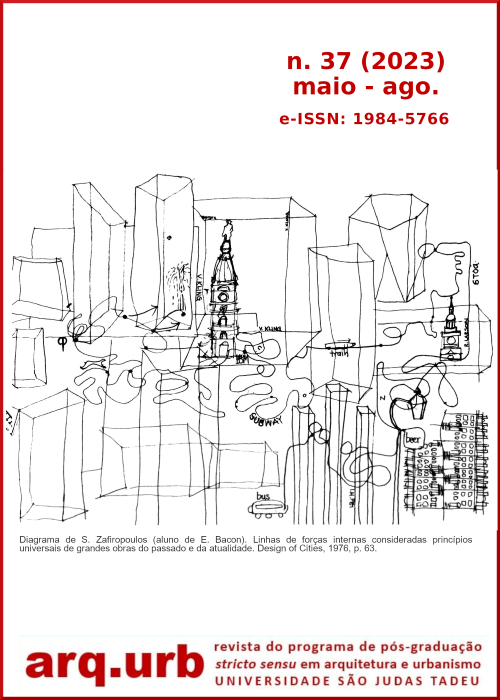The protection of rural architecture
a typological study of buildings built in the city of Icó – CE
DOI:
https://doi.org/10.37916/arq.urb.vi37.528Keywords:
Patrimony, Sertão, InventoryAbstract
The issue of cultural heritage in Brazil, reveal trends of exclusion based on foreign styles that dictate, classify and exclude the heritage of national locations, within this panorama cultural examples of the country people
find their existence compromised by the action of time, the neglect of public protection, from the scarcity of urban planning and the advances and onslaughts of real estate capital. Icó, a municipality in the Center-South region of the State of Ceará, is one of the largest holders of historical architectural examples, its collection managed by IPHAN, however it disregarded rural buildings located in its urban and district headquarters. That said, the research seeks to analyze the current picture of these buildings, from the perspective of legislation and heritage protection. For
this, a documentation of this architecture was carried out, through a methodology supported by bibliographical and field research, data collection from the instruments of local public administration, apprehension of the place and surroundings of the non-inventoryed buildings. As a result, the research produced an analysis of its location and its typology, as part of the process for a proposal to protect the buildings.
Downloads
References
ARRAES, Damião Esdras Araújo. Curral de reses, curral de almas: urbanização do sertão nordestino entre os séculos XVII e XIX. Dissertação de mestrado. Faculdade de Arquitetura e Urbanismo da Universidade de São Paulo, FAAUSP, São Paulo, 2012.
BRASIL. Decreto Nº 6.843, de 7 de maio de 2009. Aprova a Estrutura Regimental e o Quadro Demonstrativo dos Cargos em Comissão e das Funções Gratificadas do Instituto do Patrimônio Histórico e Artístico Nacional - IPHAN, e dá outras providências. Diário Oficial da União: seção 1, Brasília, DF, 2009. Disponível em<http://portal.iphan.gov.br/uploads/legislacao/Decreto_6844_de_07_de_maio_de_2009.pdf> Acesso em: 18 set. 2018.
CARDOSO, Daniel Ribeiro. Desenho de uma Poiesis. Fortaleza: Expressão Gráfica e Editora, 2011.
CONSELHO DA EUROPA. O apelo de granada. A arquitectura rural no ordenamento do território, 1976. Cadernos de sociomuseologia, nº 15, 1999. Disponível em: <http://revistas.ulusofona.pt/index.php/cadernosociomuseologia/article/view/33>. Acesso em: 18 set. 2018.
DINIZ. Nathália Maria Montenegro. Velhas Fazendas Da Ribeira do Seridó. Dissertação de mestrado. Faculdade de Arquitetura e Urbanismo da Universidade de São Paulo, FAAUSP, São Paulo. 2008.
DINIZ. Nathália Maria Montenegro. Um Sertão Entre Tantos Outros: fazendas de gado das Ribeiras do Norte. Tese de doutorado. Faculdade de Arquitetura e Urbanismo da Universidade de São Paulo, FAAUSP, São Paulo, 2013.
DUARTE JUNIOR. Romeu. Arquitetura colonial cearense: meio-ambiente, projeto e memória. Revista CPC, nº 7, nov. 2008/abr. 2009, p. 43-73. DOI: https://doi.org/10.11606/issn.1980-4466.v0i7p43-73
ICOMOS (International Council on Monuments and Sites). Carta sobre o património construído vernáculo. Cidade do México, 17 a 23 de Outubro de 1999. Disponível em: <http://www.patrimoniocultural.gov.pt/media/uploads/cc/cartasobrepatrimoniovernaculo1999.pdf>. Acesso em: 18 set. 2018.
IPHAN. Estudo para tombamento do conjunto arquitetônico e urbanístico da cidade de Icó – Ceará. Vol 1. 4ª Coordenação Regional do IPHAN (CE/RN), 1997.
JUCÁ, Clovis Ramiro Neto. Primórdios da urbanização no Ceará. Fortaleza: UFC Edições/ Banco do Nordeste do Brasil, 2012.
LOPES, Flávio; CORREA, Miguel Brito. Património arquitectónico e arqueológico: cartas, recomendações e convenções internacionais. Lisboa: Livros Horizonte, 2004.
MAIA, Stephane de Sousa e Silva. Sertão Negro. Monografia de graduação. Quixadá: Centro Universitário Católica de Quixadá 2017.
NASCIMENTO, José. C. Redescobriram o Ceará? Editora: EDUFBA- ANPUR-PPGAU, 2011.
NEVES, Frederico de Castro. A seca na história do Ceará. In: SOUZA, Simone de; GONÇALVES, Adelaide et al (orgs.). Uma nova história do Ceará. Fortaleza: Editora Demócrito Rocha, 2004.
OGAWA, Yuka. A Arquitetura como infraestrutura social de convivência com o semiárido. Monografia de graduação. Universidade Federal do Ceará, Fortaleza, 2017.
VIEIRA, Washington Luiz Peixoto. Personagens históricos: Bernardo Duarte Brandão. O Barão do Crato. 2008. Disponível em: <https://iconacional.blogspot.com/search?q=Bernardo+Duarte+Brand%C3%A3o > Acesso em: 12 mar. 2019.
WEIMER, Gunter. Arquitetura Popular Brasileira. São Paulo: Martins Fontes, 2012.
Downloads
Published
How to Cite
Issue
Section
License
Copyright (c) 2023 Glaudemias Grangeiro Júnior; Hortênsia Gadelha Maia; João Lucas Vieira Nogueira; Cláudia Sales de Alcântara.

This work is licensed under a Creative Commons Attribution-NonCommercial 4.0 International License.
Authors hold copyright without any restrictions, being required to inform the initial publication in this journal in the event of a new publication of any work.

















